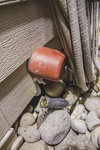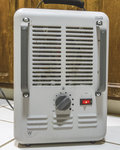

Was your home prepared for the first snow and ice storm of 2016? If not, there are several things you can do on your own – or with a little help from your friends – to keep your house feeling warm and cozy when the next, inevitable winter storm hits Clark County.
“There are a few things, I call them low-hanging fruit, that you can do right away,” says Mike Selig, program manager for the county’s weatherization program. “One of the big things for homeowners who have just a constant feeling of chills in the house, is to check the crawl spaces under the kitchen and under the bathroom.”
Selig says he recently fixed his own home’s chilly bathroom using sheet foam.
“I had drafty toes in my bathroom,” Selig says. “And, sure enough, when I crawled under there, it was just a big hole.”
Contractors often “rough in” a hole beneath tubs and showers to run pipes, Selig says, and those open spaces can make the room above feel especially drafty during the winter months.
To warm his own home’s chilly bathroom floor, Selig installed sheet foam – a type of rigid insulation usually made of polystyrene or polyurethane that is sold at home improvement stores like The Home Depot and Lowe’s – in the open area beneath his bathroom floor.
Selig says another “low-hanging fruit” for winter weatherization is found near your home’s furnace.
“If you have a furnace, go look at the duct work around it,” Selig says. “Sealing leaks near the (furnace’s) ductwork can make a big difference.”
To see if your furnace ductwork has a leak, look for two big metal boxes near your furnace. The box connected to the top of your furnace is the one that should be blowing air out. The other box, which connects to your air filter, pulls air in. If you put a piece of tissue paper over the ductwork that is supposed to be blowing air out and it doesn’t blow the paper upward, you’ll know that you have a leak in your furnace ductwork. You can seal those leaks with metal foil HVAC tape or by painting a nickel-thick layer of duct mastic around the duct joint. Most experts recommend using the mastic, a gooey, gap-filling sealant that sticks to metal and conforms to any shape, for long-term seals.
Selig says you can do a quick test for other, smaller leaks by heating your home and then turning the heat off, but keeping the exhaust fans on. After this, wet the back of your hand and place it near your baseboards, outlets, cabinets in the kitchen and other drafty areas.
“You should be able to feel the (drafts),” Selig says. “Then you can get at those leaks. If they’re visible leaks, you can use a caulking gun with a latex caulk, or you can use spray-in foam for the ones that (are not visible).”
Once you’ve taken care of the big DIY projects, Selig says you can look for other, more quick-fix solutions to beating back winter weather inside your home.
Here are a few of Selig’s suggestions:
• Use curtains to your home’s advantage. When the sun is out during the winter months, open those curtains wide and let the solar-powered warmth heat your home from the outside. When the sun goes back down, close those curtains tight to retain the heat inside your living spaces.
• If you have an air leak coming from under your doors, try rolling up a towel and plugging that gap. “Some people get tired of having (the rolled-up towel) in the way,” Selig adds. “So if you don’t like the towel, there are door sweeps you can buy to stop the air leak.”
• Call the Clark Public Utilities’ energy desk at (360) 992-3355 for more suggestions about how to best weatherize your home during the winter months. “They are fantastic to work with,” Selig says. “And they have experts who rotate on the energy desk and can answer your questions.”
• Check into incentive programs, such as the ones that Energy Trust of Oregon offers to homeowners in Oregon as well as southwest Washington. For information on that program, visit https://energytrust.org.
• Look into the energy efficiency tips and sustainable building practice ideas on Planet Clark, a county program that Selig also manages. Planet Clark, an energy efficiency educational outreach program recently partnered with Habitat for Humanity to build an energy efficient house, and has resources available online for homeowners interested in making their home more sustainable and energy efficient. The Planet Clark website, at www.planetclark.com, also lists home performance contractors on their Partners page.
If you can’t afford to weatherize your home, check into the county’s weatherization program. This grant-funded program is free for income-qualified households in Clark County and helps homeowners (and low-income renters who have their landlord’s approval and meet the program’s other criteria) improve their home’s energy efficiency and indoor air quality.
The popular program has a waitlist year-round and funds to complete between 110 and 120 houses each year. Selig says the best time to sign up for the weatherization program is in the springtime. “By the end of summer and early fall, we usually have a waitlist,” he says. Priority is given to people who are over the age of 60, have children ages 6 and younger in the home or who have already been on the waitlist for a year. To qualify, a household must make less than 125 percent federal poverty level ($2,526 per month for a family of 4).
All applicants for the county’s weatherization program are collected through the Clark Public Utilities’ Low-Income Home Energy Assistance (LIHEAP) program, which provides heating bill assistance to qualified households. For more information about the LIHEAP program or the weatherization program, visit www.clarkpublicutilities.com/index.cfm/payment-options/assistance-programs/liheap or www.clark.wa.gov/development/building/weatherization.html, or call 1-855-353-HEAT(4328).
Below are a few other tips from the American Red Cross, the federal government and Energy Star for keeping your home safe and sound (and warm) this winter season:
* Reduce heat loss from the fireplace by keeping the fireplace damper closed whenever you do not have a fire burning. You can also add caulking around your fireplace hearth to prevent air leaks.
* Cover drafty windows with a heavy-duty, clear plastic sheet. Make sure that you have sealed the plastic sheeting tightly to the window frame to reduce cold air leaks.
* Maintain your heating system with scheduled furnace tune-ups and filter replacements. This is something that the county’s weatherization program often includes in their free service for low-income qualifying households.
* Maintain an even temperature in your home throughout the day, even if you’re away from the house. Experts say an inside temperature of between 55 and 60 degrees is optimal for when you’re out of the house. Once you’re home, turn the temperature up slightly, but not excessively. Turning your thermostat all the way up stresses your heating system and doesn’t actually heat the home any faster.
* Do what your grandparents probably told you to do – dress warmly, even when you’re inside, and close the doors to rooms that you’re not using as frequently during the winter months.
* Prevent frozen pipes by keeping your garage doors closed (if there are water lines in your garage), keeping your thermostat set no lower than 55 degrees, opening the kitchen and bathroom cabinets to let warm air circulate near the pipes, and running water in a slow trickle so water inside the lines won’t stagnate and freeze. Also, adding insulation to your attic, basement and crawl spaces will help maintain a higher temperature in those areas and better protect your plumbing.
* Thaw already frozen pipes by keeping the faucet open and applying heat to the section of pipe with an electric heating pad, electric hair dryer or with towels soaked in hot water and then wrapped around the pipe. How to tell if your pipes are frozen? Turn on your faucet. Is there just a trickle of water coming out? You probably have a frozen pipe. And, experts say, if one pipe is frozen, chances are good that there are others, so you may want to check other faucets since frozen pipes can burst during cold-weather events.